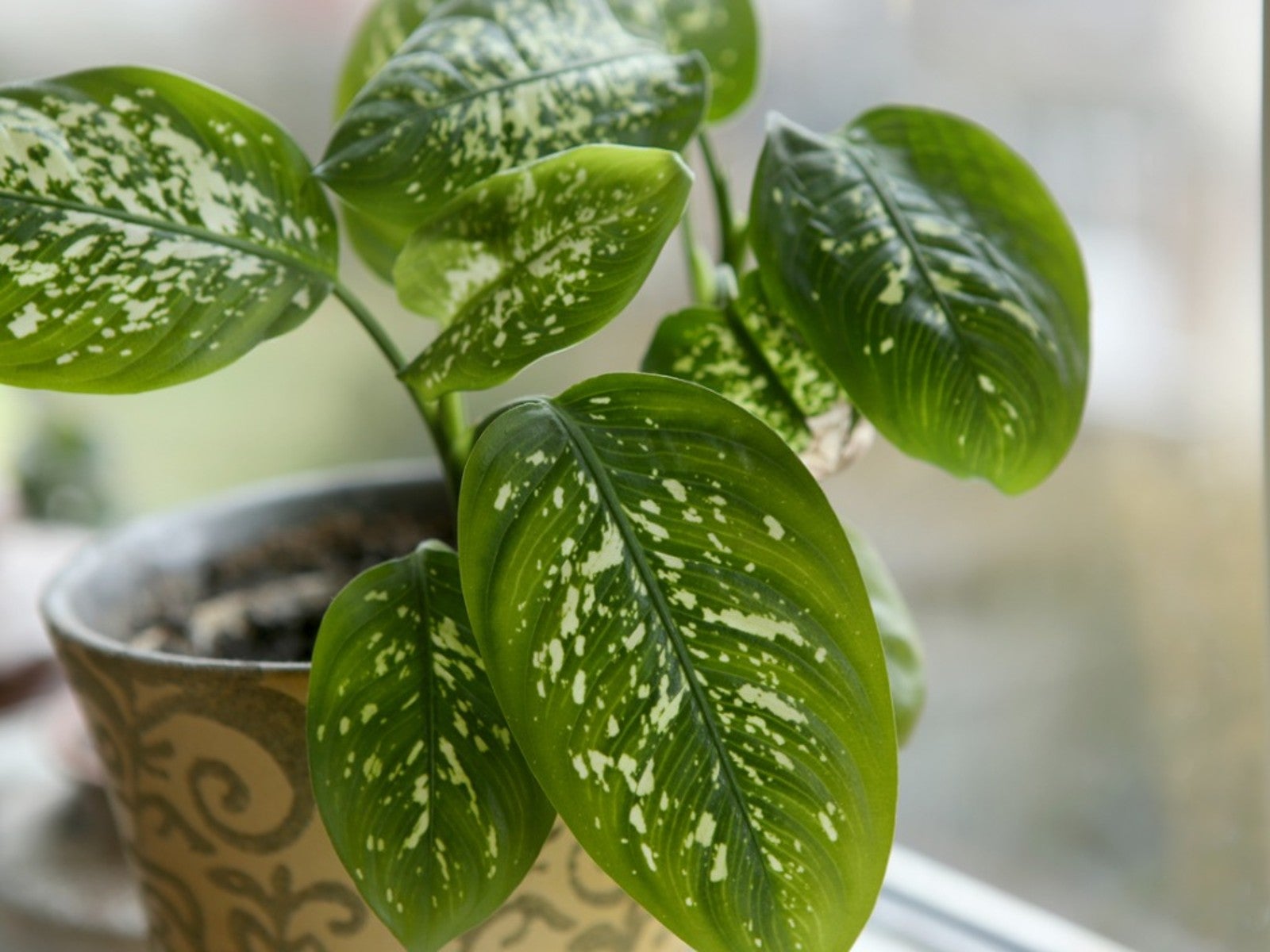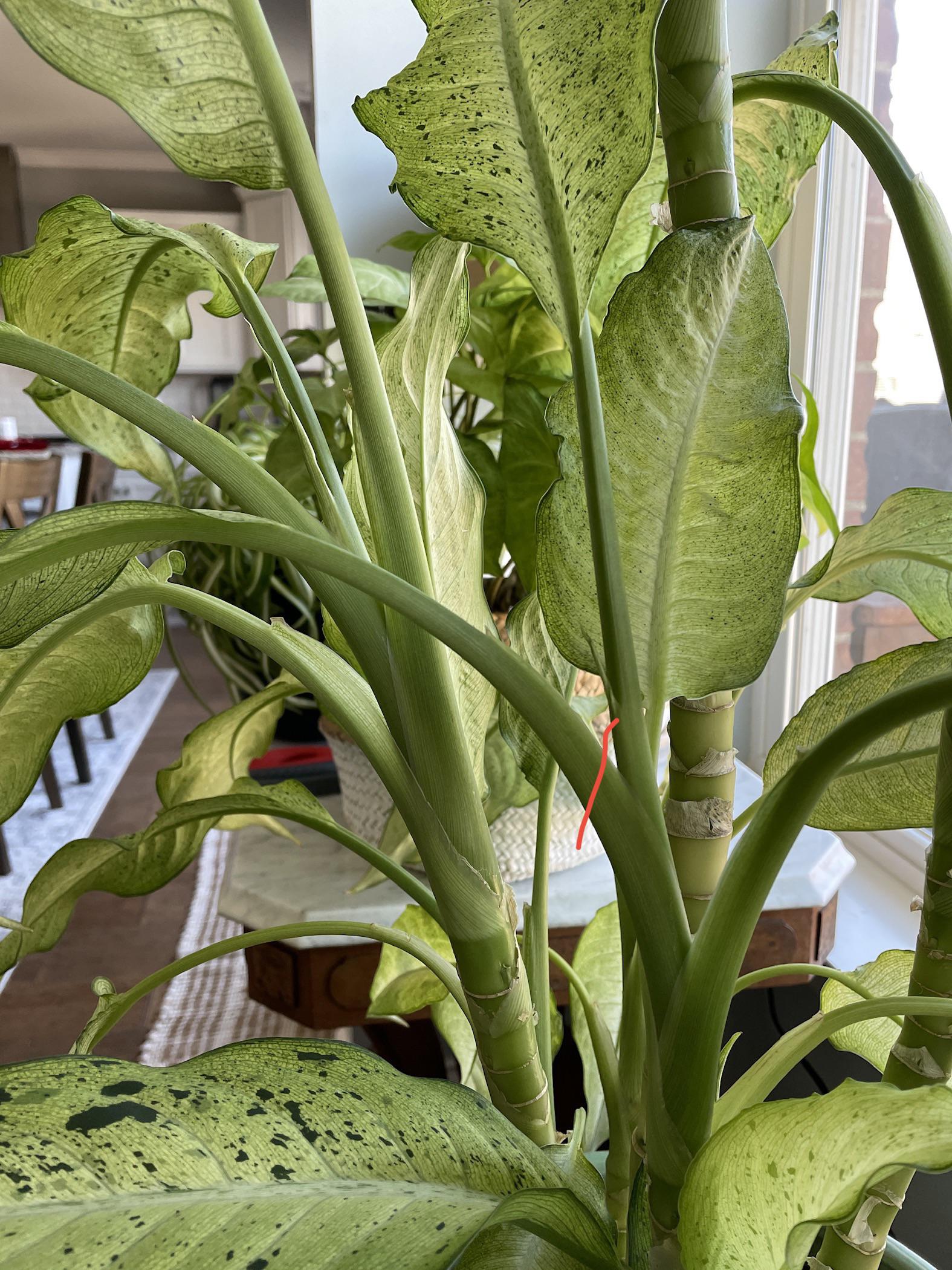To prune a Dieffenbachia, remove any dead or yellowing leaves and trim back overgrown stems or branches. Dieffenbachia plants, also known as dumb cane plants, are popular houseplants known for their beautiful foliage.
However, as with any plant, they may require occasional pruning to promote healthy growth and maintain their shape. Pruning a Dieffenbachia involves removing any dead or yellowing leaves, as well as pruning back overgrown stems or branches to encourage new growth.
We will discuss how to properly prune a Dieffenbachia plant to help it thrive. Whether you are a seasoned gardener or a beginner, you will find these tips and techniques useful in maintaining a healthy and attractive Dieffenbachia plant. So, let’s dive in and discover the art of pruning Dieffenbachia.

Credit: www.gardeningknowhow.com
Understanding Dieffenbachia Pruning
Pruning plays a crucial role in maintaining healthy Dieffenbachia plants. Regular pruning helps to promote growth and prevent the plant from becoming overgrown. It allows for better airflow and light penetration, leading to improved overall plant health. Pruning also helps to remove dead or damaged leaves, reducing the risk of pests and diseases.
When pruning Dieffenbachia, it is important to use sharp and clean pruning tools to avoid damaging the plant. Start by removing any yellow or discolored leaves, cutting them back to the base of the stem. You can also prune back leggy stems to encourage bushier growth. Remember to always dispose of pruned plant material properly to prevent the spread of pests or diseases.
Regular pruning, typically done every 1-2 months, will help to keep your Dieffenbachia looking neat and vibrant. Not only does it enhance the aesthetic appeal of the plant, but it also contributes to its overall well-being. By following proper pruning techniques, you can ensure the longevity and vitality of your Dieffenbachia plant.
| Benefits of regular pruning for Dieffenbachia plants: |
|---|
| Promotes growth: Pruning encourages new growth and helps the plant to maintain a compact shape. |
| Improves plant health: Pruning allows for better airflow and light penetration, reducing the risk of pests and diseases. |
| Revitalizes appearance: Removing old or damaged leaves helps to keep the plant looking fresh and vibrant. |
| Prevents overgrowth: Pruning prevents Dieffenbachia from becoming excessively tall or leggy. |
| Encourages bushier growth: Trimming back leggy stems promotes branching, resulting in a fuller and more visually appealing plant. |
When To Prune Dieffenbachia
Pruning plays a crucial role in maintaining the health and appearance of Dieffenbachia plants. Knowing when to prune your Dieffenbachia is essential for promoting new growth and keeping the plant in shape. One sign that indicates the need for pruning is when your Dieffenbachia becomes leggy or overgrown. This means that it has outgrown its current space and requires pruning to encourage compact growth.
Another sign is the presence of yellow or brown leaves. If you notice these, it could be an indication of old or damaged foliage that needs to be trimmed away. Additionally, if you observe any diseased or pest-infested parts on your Dieffenbachia, these should be removed promptly to prevent the spread of infection.
When it comes to the frequency of pruning, it is generally recommended to prune Dieffenbachia plants once every two to three years. However, if you notice signs of overgrowth or significant damage, you may need to prune more frequently. Remember to use clean and sharp pruning tools to make clean cuts and reduce the risk of introducing pathogens.
| Signs that your Dieffenbachia needs pruning |
|---|
| – Leggy or overgrown appearance |
| – Yellow or brown leaves |
| – Diseased or pest-infested parts |
Proper pruning techniques, along with regular care and maintenance, will help your Dieffenbachia thrive and stay visually appealing.
How to Prune Dieffenbachia : Step by Step Guide
Pruning Dieffenbachia is an important task to maintain its health and promote growth. To ensure effective pruning, you will need a few essential tools:
| Pruning shears | To make clean cuts and avoid damaging the plant |
| Gloves | To protect your hands from the plant’s sap, which can cause skin irritation |
Here is a step-by-step guide to help you successfully prune your Dieffenbachia:
- Start by removing any dead or damaged leaves. These can hinder the plant’s growth and become a breeding ground for pests.
- Next, identify any overgrown stems and cut them back to a desirable length to maintain the plant’s shape and prevent it from becoming too large.
- To further shape the plant, trim the outer growth and any straggly stems.
- While pruning, make sure to use appropriate techniques such as cutting at a 45-degree angle to encourage new growth.
By regularly pruning your Dieffenbachia using these techniques, you can promote its overall health and ensure it remains an attractive addition to your indoor space.
Tips For Maintaining Dieffenbachia After Pruning
| Proper watering after pruning |
After pruning, it is crucial to provide your Dieffenbachia plant with proper watering. Ensure that the soil is moist, but not waterlogged. Overwatering can lead to root rot, while underwatering can cause the plant to dry out. To maintain the right moisture level, water the plant when the top inch of soil feels dry. Avoid leaving the plant in standing water, as this can also lead to root issues.
Additionally, providing adequate sunlight is essential for the fresh growth of your Dieffenbachia. Place the plant in a well-lit area but avoid direct sunlight, as it can scorch the leaves. A good location would be near a window with filtered sunlight.
Preventing pests and diseases is another crucial aspect of maintaining your Dieffenbachia. Inspect the plant regularly for signs of pests such as mealybugs or spider mites. If necessary, use appropriate insecticidal soap or natural remedies to eliminate them. Moreover, ensure good air circulation around the plant to prevent fungal diseases.
Lastly, post-pruning, it is important to fertilize and care for your Dieffenbachia properly. Use a balanced liquid fertilizer once a month during the growing season. Keep an eye on the plant’s overall health, and trim any dead or yellowing leaves promptly to promote new growth.
Common Pruning Mistakes To Avoid With Dieffenbachia
| Common Pruning Mistakes to Avoid with Dieffenbachia |
|---|
| Over-pruning and its consequences |
|
Pruning dieffenbachia excessively can have negative consequences on the plant’s health and appearance. While it is important to maintain the plant’s shape and size, over-pruning can result in weakened stems and stunted growth. It is crucial to be mindful of the amount of foliage and branches removed, as excessive pruning can leave the dieffenbachia vulnerable to diseases and pests. Pruning at the wrong time Timing is crucial when it comes to pruning dieffenbachia. Pruning during its active growth period, which is typically spring and summer, allows the plant to recover quickly and encourages new growth. Pruning during the dormant phase, typically in winter, can hinder the plant’s ability to regenerate and may cause unnecessary stress. Incorrect pruning techniques and their impact Using improper pruning techniques can lead to irreversible damage to the dieffenbachia. It is essential to use sharp, clean tools to make clean cuts and avoid tearing or crushing the plant’s tissue. Incorrect cutting angles, such as cutting too close to the main stem or leaving stubs, can result in slow healing and increased susceptibility to diseases. It is best to research and follow proper pruning guidelines to ensure the plant’s overall health and aesthetics. |
Frequently Asked Questions About Pruning Dieffenbachia
Dieffenbachia plants are beautiful and popular houseplants, but they can require regular pruning to keep them healthy and looking their best. Here are some commonly asked questions about pruning Dieffenbachia:
Can I use pruning shears for Dieffenbachia?
Yes, pruning shears are a great tool for pruning Dieffenbachia. The sharp, clean cuts they provide will minimize damage to the plant and promote healthy growth.
Is it necessary to prune Dieffenbachia regularly?
Regular pruning is not necessary for Dieffenbachia, but it can be beneficial. Pruning helps remove dead or yellowing leaves, keeps the plant compact, and prevents it from becoming too leggy.
Can I propagate Dieffenbachia from pruned cuttings?
Absolutely! Dieffenbachia can be propagated from stem cuttings. Simply take a cutting from a healthy plant, remove the lower leaves, and place it in water or soil to encourage root growth.
| Question | Answer |
|---|---|
| Can I use pruning shears for Dieffenbachia? | Yes, pruning shears are a great tool for pruning Dieffenbachia. The sharp, clean cuts they provide will minimize damage to the plant and promote healthy growth. |
| Is it necessary to prune Dieffenbachia regularly? | Regular pruning is not necessary for Dieffenbachia, but it can be beneficial. Pruning helps remove dead or yellowing leaves, keeps the plant compact, and prevents it from becoming too leggy. |
| Can I propagate Dieffenbachia from pruned cuttings? | Absolutely! Dieffenbachia can be propagated from stem cuttings. Simply take a cutting from a healthy plant, remove the lower leaves, and place it in water or soil to encourage root growth. |
Frequently Asked Questions Of How To Prune Dieffenbachia
What To Do When Dieffenbachia Gets Too Tall?
To manage a dieffenbachia that has grown too tall, you can trim or prune it. Cut back the stems to the desired height, making sure to use sharp, clean tools. Also, consider repotting the plant in a larger container to support its growth.
How Do You Cut Leggy Dieffenbachia?
To cut leggy dieffenbachia, take sharp shears and trim the plant back by removing the overgrown stems. Make the cut just above a leaf node to encourage new growth. Optionally, you can propagate the cuttings in water or soil to grow new plants.
Maintain regular pruning to prevent legginess.
How Do You Make Dieffenbachia Bushy?
To make a dieffenbachia bushy, prune it regularly, cutting back the top growth to promote lateral branching. Place the plant in bright, indirect light and water it when the top inch of soil feels dry. Use a well-draining soil mix and fertilize monthly during the growing season.
Should You Cut Yellow Leaves Off Dieffenbachia?
Yes, you should cut yellow leaves off dieffenbachia.
Conclusion
Pruning Dieffenbachia doesn’t have to be an intimidating task. By following the steps outlined in this guide and maintaining regular care, you can ensure your plant remains healthy and vibrant. Remember to use clean tools, identify the right areas to trim, and provide proper conditions for growth.
By keeping your Dieffenbachia well-pruned, you can enjoy a stunning and thriving plant in your home or office. Happy pruning!

